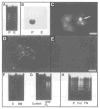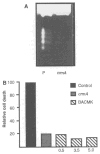Suppression of ICE and apoptosis in mammary epithelial cells by extracellular matrix
- PMID: 7531366
- PMCID: PMC3004777
- DOI: 10.1126/science.7531366
Suppression of ICE and apoptosis in mammary epithelial cells by extracellular matrix
Abstract
Apoptosis (programmed cell death) plays a major role in development and tissue regeneration. Basement membrane extracellular matrix (ECM), but not fibronectin or collagen, was shown to suppress apoptosis of mammary epithelial cells in tissue culture and in vivo. Apoptosis was induced by antibodies to beta 1 integrins or by overexpression of stromelysin-1, which degrades ECM. Expression of interleukin-1 beta converting enzyme (ICE) correlated with the loss of ECM, and inhibitors of ICE activity prevented apoptosis. These results suggest that ECM regulates apoptosis in mammary epithelial cells through an integrin-dependent negative regulation of ICE expression.
Figures




References
Publication types
MeSH terms
Substances
Grants and funding
LinkOut - more resources
Full Text Sources
Other Literature Sources
Molecular Biology Databases

